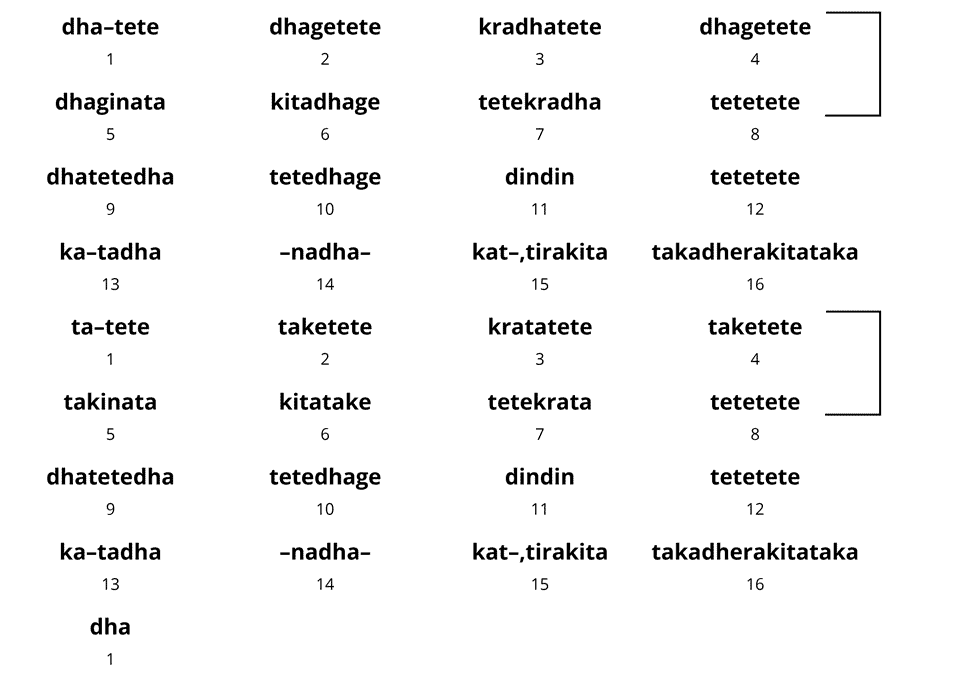Fard – फर्द
Quick Definition: A fixed, cadential form which typically has a cyclic structure. Uses mostly pakhawaj phrases. Performed in tabla solo.
Literal Meaning: single; sole; unequalled
Pronunciation: phard
Example Fard

(from Benares Fard 1)
Introduction to Fard
The fard is another form that is mostly associated with the Benares gharana. Similar in form to the gat, the fard is not easy to categorize; it is fixed, cyclic, and strongly cadential.
However, it differs from the typical Benares gat in a number of ways, including a more limited set of bols (phrases), a stronger movement towards sam (the 1 of the cycle), and a lack of parallel halves typical of the most common gats. We’ll look at all of these below.
Because the fard is one of the most guarded specialties of Benares, there have been relatively few fards published in books. And most Benares masters will not share them with anyone but select students. So there may be more variety and creativity in the form than most of us know.
In his book Tabla Granth, Chhotelal Misra published pure fards, and two-part fards known as gat-fards. We’ll look at examples of these below.
Fard Bols and Composition
In comparison to the gat, the typical fard uses a more limited set of bols (phrases) coming mostly from the pakhawaj. These phrases are similar to many tukras or parans, but they are composed in a very particular way.
As Rebecca Stewart observed, the fard creates a tension that increases until the final sam (the 1 of the next cycle) (p. 218). For this reason, most fards are short.
In order to create this tension, fard bols are typically asymetrical, especially as they get closer to the sam. The typical gat, on the other hand, will use symetrical phrasing.
Related to this point, the pure fard also does not have parallel halves, as the most common gats do. The second half may begin with khali (unstressed) bols, but they do not match the bols of the first half.
We see this in the example fard above; the second half begins with khali bols (matras 8–10) but they are not parallel with the first half. (Note that not all fards include a khali section.)
The Fard Ending Phrase
The most defining feature of the Benares fard is the ending phrase. This is the phrase that resolves the tension mentioned above by bringing it to sam.
Every fard will end with one of the phrases below (or a very similar one):
- tirakiṭatakatā– ka–dherakiṭataka dhā / तिरकिटतकताऽ कऽधेरकिटतक धा
- tirakiṭatakatā– ge–dherakiṭataka dhā / तिरकिटतकताऽ गेऽधेरकिटतक धा
- –kiṭataka tirakiṭatakatā– ge–dherakiṭataka dhā / –किटतक तिरकिटतकताऽ गेऽधेरकिटतक धा
- –tirakiṭa takadherakiṭataka dhā / –तिरकिट तकधेरकिटतक धा
- –dherakiṭataka dhā / –धेरकिटतक धा
The phrase dherakitataka dha is particularly difficult to play. This bol alone makes the fard an advanced composition.
The Gat-Fard
In Benares there is also a hybrid form know as gat-fard. Here the fard’s composition may be essentially the same as a pure fard, but it will have the two-part form of the common gat. This means the second half will begin with a khali (unstressed) version of the opening bols of the first half.
In the gat-fard below, matras 1–8 in each half are tali-khali counterparts. All other bols are the same in each half:

Aside from the parallel contruction, this gat-fard is no different than a pure fard. So one could play only the first 16 matras, then finish with dha, and it would be an acceptable fard.
References
Misra, Chhote Lal. Tal Prabandh New Delhi: Kanishka Publishers, 2006. (Hindi)
—. Tabla Granth. New Delhi: Kanishka Publishers, 2006. (Hindi)
Naimpalli, Sadanand. Tabla for Advanced Students. Mumbai: Popular Prakashan Pvt. Ltd., 2009.
Shepherd, Frances Ann. Tabla and the Benares Gharana. Unpublished Ph.D. thesis, Wesleyan University, Middletown Connecticut, 1976.
Stewart, Rebecca Marie. The Tabla in Perspective. Unpublished Ph.D. thesis, University of California, Los Angeles, 1974.